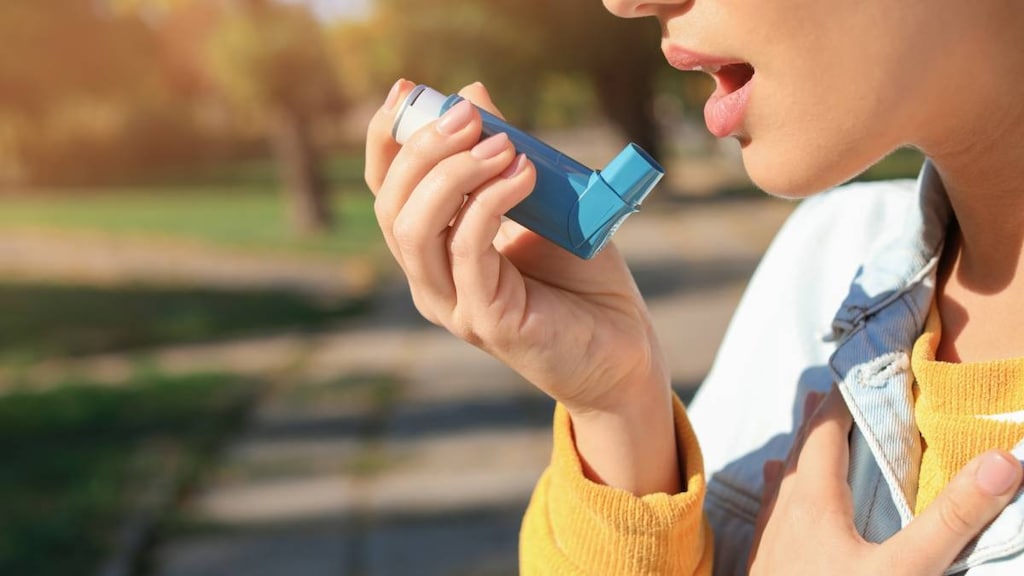What is Dulera?
- Dulera combines an inhaled corticosteroid medicine (ICS), mometasone furoate, and a long-acting beta2-agonist medicine (LABA), formoterol.
- ICS medicines such as mometasone furoate help to decrease inflammation in the lungs. Inflammation in the lungs can lead to breathing problems.
- LABA medicines such as formoterol help the muscles around the airways in your lungs stay relaxed to prevent asthma symptoms, such as wheezing, cough, chest tightness, and shortness of breath. These symptoms can happen when the muscles around the airways tighten. This makes it hard to breathe.
- Dulera is not used to relieve sudden breathing problems and will not replace a rescue inhaler.
- It is not known if Dulera is safe and effective in children less than 5 years of age.
- Dulera is used for asthma as follows:
- Dulera is a prescription medicine used to control symptoms of asthma and prevent symptoms such as wheezing in people 5 years of age and older.
- Dulera contains formoterol. LABA medicines such as formoterol when used alone increase the risk of hospitalizations and death from asthma problems. Dulera contains an ICS and a LABA. When an ICS and LABA are used together, there is not a significant increased risk in hospitalizations and death from asthma problems.
- Dulera is not for adults and children with asthma who are well controlled with an asthma control medicine, such as a low to medium dose ICS medicine. Dulera is for adults and children with asthma who need both an ICS and LABA medicine.
Who should not take Dulera
Do not use Dulera:
- to treat sudden severe symptoms of asthma.
- as a rescue inhaler.
- if you are allergic to any of the ingredients in Dulera. See the end of this Patient Information guide for a list of ingredients in Dulera.
What should I tell my healthcare provider before taking Dulera?
Before and during treatment with Dulera, tell your healthcare provider about all of your medical conditions, including if you:
- have heart problems.
- have high blood pressure.
- have seizures.
- have thyroid problems.
- have diabetes.
- have liver problems.
- have osteoporosis.
- have an immune system problem.
- have eye problems such as increased pressure in the eye, glaucoma, cataracts, blurred vision, or other changes in your vision.
- are allergic to any medicines.
- are exposed to chickenpox or measles.
- have an aneurysm (swelling of an artery).
- have a pheochromocytoma (a tumor of the adrenal gland that can affect your blood pressure).
- are scheduled to have surgery.
- are pregnant or planning to become pregnant. It is not known if Dulera may harm your unborn baby.
- are breastfeeding. It is not known if Dulera passes into your milk and if it can harm your baby. You and your healthcare provider should decide if you will take Dulera while breastfeeding.
Tell your healthcare provider about all the medicines you take including prescription and over-the-counter medicines, vitamins, and herbal supplements. Dulera and certain other medicines may interact with each other. This may cause serious side effects.
Especially, tell your healthcare provider if you take antifungal medicines, such as ketoconazole, or anti-HIV medicines, such as ritonavir and cobicistat-containing products. The anti-HIV medicines norvir (ritonavir capsules) soft gelatin, norvir (ritonavir oral solution), and kaletra (lopinavir/ritonavir) Tablets contain ritonavir.
For some medicines (including medicines for HIV such as ritonavir, cobicistat-containing products, and certain antifungals and antibiotics) your doctor may wish to monitor you carefully.
Know the medicines you take. Keep a list and show it to your healthcare provider and pharmacist each time you get a new medicine.
How should I use Dulera?
See the step-by-step instructions for using Dulera that come with your medication. Do not use Dulera unless your healthcare provider has taught you and you understand how to use it. Ask your healthcare provider or pharmacist if you have any questions.
- Use Dulera exactly as prescribed. Do not use Dulera more often than prescribed. Dulera comes in 3 strengths. Your healthcare provider has prescribed the strength that is best for you. Note the differences between Dulera and your other inhaled medicines, including the differences in prescribed use and physical appearance.
- For children aged 5 to less than 12 years, use Dulera 50 mcg/5 mcg.
- For adults and adolescents 12 years of age and older, use Dulera 100 mcg/5 mcg or Dulera 200 mcg/5 mcg.
- Dulera should be taken every day as 2 puffs in the morning and 2 puffs in the evening.
- If you miss a dose of Dulera, skip your missed dose and take your next dose at your regular time. Do not take Dulera more often or use more puffs than you have been prescribed.
- While you are using Dulera 2 times each day, do not use other medicines that contain a long-acting beta2-agonist (LABA) for any reason. Ask your healthcare provider or pharmacist if any of your other medicines are LABA medicines.
- If you take more Dulera than your healthcare provider has prescribed, get medical help right away if you have any unusual symptoms, such as problems breathing, palpitations, chest pain, increased heart rate, nervousness or shakiness.
- Do not change or stop using Dulera or other asthma medicines used to control or treat your breathing problems unless told to do so by your healthcare provider. Your healthcare provider will change your medicines as needed.
- Dulera does not relieve sudden asthma symptoms. Always have a rescue inhaler with you to treat sudden symptoms. Use your rescue inhaler if you have breathing problems between doses of Dulera. If you do not have a rescue inhaler, call your healthcare provider to have one prescribed for you.
- Remove the cap from the mouthpiece of the actuator before using Dulera.
- Do not remove the canister from the actuator because:
- You may not receive the correct amount of medicine.
- The dose counter may not function properly.
- Reinsertion may cause the dose counter to count down by 1 and may discharge a puff.
- After each dose (2 puffs) of Dulera, rinse your mouth with water. Spit out the water. Do not swallow it. This will help to lessen the chance of getting a yeast infection (thrush) in the mouth and throat.
- Prime (sprays released into the air before use) your inhaler away from your face. Do not spray Dulera in your eyes. If you accidentally get Dulera in your eyes, rinse your eyes with water and if redness or irritation continues, call your healthcare provider.
- Call your healthcare provider or get medical care right away if:
- your breathing problems worsen with Dulera
- you need to use your rescue inhaler more often than usual
- your rescue inhaler does not work as well for you at relieving symptoms
- you need to use 4 or more inhalations of your rescue inhaler for 2 or more days in a row
- you use 1 whole canister of your rescue inhaler in 4 weeks' time
- your peak flow meter results decrease. Your healthcare provider will tell you the numbers that are right for you.
- your asthma symptoms do not improve after using Dulera regularly for 2 weeks
What are the possible side effects of Dulera?
Dulera may cause serious side effects, including:
- Thrush in the mouth and throat. You may develop thrush, a yeast infection (Candida albicans), in your mouth or throat. After each dose of Dulera (2 puffs), rinse your mouth with water. Spit out the water. Do not swallow it. This will help to prevent thrush in your mouth or throat.
- Immune system effects and a higher chance for infections. Signs of infection may include:
- fever
- nausea
- chills
- feeling tired
- body aches
- pain
- vomiting
- Adrenal insufficiency. Adrenal insufficiency is a condition in which the adrenal glands do not make enough steroid hormones. This can happen when you stop taking oral corticosteroid medicines and start inhaled corticosteroid medicines.
- Increased wheezing right after taking Dulera. Always have a rescue inhaler with you to treat sudden wheezing.
- Serious allergic reactions. Call your healthcare provider or get emergency medical care if you get any of the following symptoms of a serious allergic reaction:
- rash
- swelling, including swelling of the face, mouth, and tongue
- hives
- breathing problems
- Using too much of a LABA medicine may cause:
- chest pain
- a fast and irregular heartbeat
- tremor
- dizziness
- seizures
- increased or decreased blood pressure
- headache
- nervousness
- weakness
- electrocardiogram (ECG) changes
- Lower bone mineral density. This may be a problem for people who already have a higher chance for low bone density (osteoporosis).
- Slowed growth in children. A child's growth should be checked often.
- Eye problems including glaucoma, cataracts, and blurred vision. You should have regular eye exams while using Dulera.
- Decreases in blood potassium levels (hypokalemia).
- Increases in blood sugar levels (hyperglycemia).
The most common side effects reported while using Dulera include:
- inflammation of the nose and throat (nasopharyngitis)
- inflammation of the sinuses (sinusitis)
- headache
- flu
- upper respiratory infection
Tell your healthcare provider about any side effect that bothers you or that does not go away.
These are not all the side effects of Dulera. Ask your healthcare provider or pharmacist for more information.
Call your doctor for medical advice about side effects. You may report side effects to FDA at 1-800-FDA-1088.
You may also report side effects to Merck Sharp & Dohme Corp., a subsidiary of Merck & Co., Inc., at 1-877-888-4231.
General Information about the safe and effective use of Dulera.
Medicines are sometimes prescribed for purposes other than those listed in the Patient Information leaflet. Do not use Dulera for a condition for which it was not prescribed. Do not give your Dulera to other people, even if they have the same condition. It may harm them.
You can ask your healthcare provider or pharmacist for information about Dulera that was written for healthcare professionals.
How should I store Dulera?
- Store Dulera at room temperature between 68°F to 77°F (20°C to 25°C).
- The 120-actuation inhaler can be stored in any position. For the 60-actuation inhaler, after priming, store the inhaler with the mouthpiece down or sideways.
- The contents of your Dulera are under pressure. Do not puncture. Do not use or store near heat or open flame. Storage above 120°F may cause the canister to burst.
- Do not throw container into fire or incinerator.
- Keep Dulera and all medicines out of the reach of children.
What are the ingredients in Dulera?
Active ingredients: mometasone furoate and formoterol fumarate dihydrate
Inactive ingredients: hydrofluoroalkane (HFA-227), anhydrous alcohol and oleic acid
For more information about Dulera: Go to www.DULERA.com or call 1-800-622-4477.




